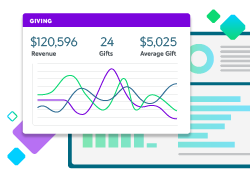Fundraiser Burnout? Try Automation to Boost Both Efficiency and Employee Morale

If your fundraising team is stressed and stretched too thin, you’re not alone. Burnout is widespread. Job cuts across all industries have increased 396% compared to the first quarter of 2022. Employees still on the roster often have a considerably heavier workload, resulting in 77% of workers feeling burned out at work.
The impact of burnout is particularly significant for nonprofit organizations. A recent study by the Chronicle of Philanthropy found that long hours and limited staff support has almost half of fundraisers eyeing the door, with 28% planning to leave the profession altogether. Unfilled fundraising positions have left 90% of fundraisers with more work and more stress:
94% feel tremendous pressure to succeed
82% say fundraisers are underappreciated
91% want more time with donors
76% want more time off
It’s Time for Automation
Automation is a simple step that can immediately improve efficiency, productivity, and job satisfaction. So much of a fundraiser’s day is tracking, reporting, researching, and analyzing. Elements of those tasks are perfectly suited to automation. Think of automation as a tool to help your team focus on the uniquely human skills of creativity, relationship building, and critical thinking that only they can bring to their fundraising roles.
90% of knowledge workers who say automation has improved the workplace
2/3 of knowledge workers who say automation makes them more productive
65% of knowledge workers who say automating manual tasks improves stress levels at work
2:1+ return on investment of skill development vs. time saved
Automation is not a cure-all for overloaded gift officers, but it goes a long way in demonstrating that your organization cares about its employees and is committed to keeping the workload manageable.
How Automation Can Help You Retain Fundraisers
Automating business processes saves time and resources so your team can focus on support for your cause and the more challenging elements of the job, instead of the repetitive, monotonous tasks that sap energy and so much of a fundraiser’s time. But it’s more than simply saving a handful of keystrokes here and there. Automation can help your staff feel more satisfied in their roles and more motivated to support your mission. Automating just a few tasks in your fundraising team’s workflow delivers interconnected benefits.
Operate More Efficiently
Gartner projects that 70% of organizations will implement structured automation by 2025. Why? Automation can improve accuracy and standardization. It also reduces the potential for error and duplication of work. Many nonprofits are way ahead of the game. Those that have already adopted automation are seeing amazing gains in efficiency.
300+ annual work hours saved automating gift notifications and documentation
500+ annual work hours saved automating gift reporting and documentation
Make Room for Collaboration
Fundraisers are collaborative by nature. They work with marketing, executive leadership, volunteers, accounting, donors, prospects, community leaders, and the board. Being bogged down with busy work creates an obstacle to collaboration, making it harder to brainstorm the next big idea for a fundraising event, a campaign, or a partnership. Automation can turn minutes, hours, or days of busy work into a second or two, freeing up a fundraiser’s head space and calendar space for truly creative work.
- Pro tip: Ask your fundraising team to identify their most meaningful work—the tasks they enjoy most and that deliver the most impact for your organization. Every aspect of their workflow that is not meaningful offers an opportunity for automation.
Improve Donor Interaction
Missing a chance to make a real connection with a donor is a motivation killer for gift officers. Automation can be an easy fix, especially for smaller gifts. Automating donor touchpoints, such as pre-scripted acknowledgment letters and prompts for birthday notifications, takes some of the pressure off a fundraiser’s day-to-day so they can focus on one-to-one interaction with high-value donors and personalized communications with major prospects and supporters. Automation can make sure the right message gets to the right person on the right channel.
- Pro tip: Keep track of how many hours per month you spend on manual communications, such as new donor welcome emails and receipts. Which of those communications could be automated?
Boost Employee Morale
The tasks most suitable for automation are typically the ones a fundraiser is only too happy to give over to technology. A gift officer should always be focused on the most high-value, rewarding tasks, such as analytics, strategy, and planning authentic interactions with donors. Shifting the bulk of busy work to automation can lead to higher job satisfaction and work engagement.
- Pro tip: On a list of least-loved, monotonous tasks in your fundraising workflow, identify those you have to perform multiple times a month, those that could be done overnight or on weekends, and those that could be divided into discrete tasks that could be completed separately. Would applying automation to these tasks make your staff happier at work?
5 Fundraising Process Areas Prime for Automation
If you’re ready to prevent or alleviate gift officer burnout, start with easy-to-launch automations for repetitive (yet essential) tasks that drain energy from fundraisers and keep them from pursuing opportunities.
- Prospecting: Your own team is an irreplaceable resource for prospecting, but that resource becomes even more effective when members work with wealth-screening tools that can automatically identify and assign top prospects to fundraiser portfolios alongside targeted and tailored gift outreach recommendations based on research.
- Proposal writing: Using AI tools, automatically draft major giving proposals based on programs a donor has given to, interests they have expressed, and giving history. New technology incorporating ChatGPT and other generative language tools can help you develop quality first drafts and will increasingly integrate with common productivity tools like Microsoft Word, Microsoft Power Automate, and the G-suite.
- Cultivation: Process automation can ensure frontline teams stay on top of and record all their moves and deadlines by automatically sending gift notifications, generating prompts for upcoming actions, and creating new assignments via email, Microsoft Teams, Slack, or other collaboration and project management systems.
- Fundraising: Optimize revenue from each gift using automation. Matching gift solutions, such as 360MatchPro from Double the Donation, can automate identification of company match opportunities and the fulfillment of these gifts, providing an additional revenue stream with little manual effort. And AskGenius takes away the manual effort of developing optimized ask strategies with proven results for increasing average gift size.
- Stewardship: Automate anniversary, renewal notices, lapsing reactivation campaigns, as well as routine gift acknowledgments. There are tons of choices from the Blackbaud Marketplace including the free app LetterBox by RedArc and DIY options for putting stewardship processes on autopilot so you can focus on the personal touches that only a human can do.
You Have Automation Options
Building automation into your fundraising workflow does not have to be expensive. And there are do-it-yourself options that don’t require coding experience. Here are three options for developing your first automation.
- Native capabilities: Deploy automations built into your existing systems.
- Point solutions: Select a provider to automate a set of functions or processes.
- Low-code, do-it-yourself workflows: Leverage automation platforms such as Microsoft Power Platform to use thousands of different connected apps without the need to understand or write code.
Ready to Get Started?
Building an automation project can seem daunting, but it’s simply a process of applying technology to a problem. You need to focus only on five elements, even when you do it on your own.
- Identify the process you want to automate: Select time-consuming or repetitive tasks, especially those prone to errors—see what’s possible.
- Learn your selected platform: Most low-code platforms offer tutorials, documentation, and community support—gain access now.
- Start small: Build confidence by beginning with a simple project that can be completed quickly—get automating!
- Collaborate with other users: There is a generous community of experienced citizen developers who love to share tips—you can ask anything.
- Document your project’s impact: Communicate the value of the project to stakeholders to build support for future projects by learning how to prove your ROI.
Nicole Holt, data systems project manager for Preble Street, an organization committed to addressing Maine’s homelessness crisis, decided to automate the large-gift reporting process. That first automation inspired the next.
“It was a game-changer for us,” she said. “Once we had that first workflow, with that really simple overnight gift digest email that goes out to the right people, we were able to see the value … and expand on that.”
If you’d like to explore the range of possibilities for automation, check out the Blackbaud Developer Conference. Not sure if it’s right for you? There are sessions for professional coders, citizen developers, and nonprofit staffers who have never written a line of code in their lives.
The Nonprofit CRM Built for Fundraisers
Find out how Blackbaud’s Raiser’s Edge NXT® fits your organization.

